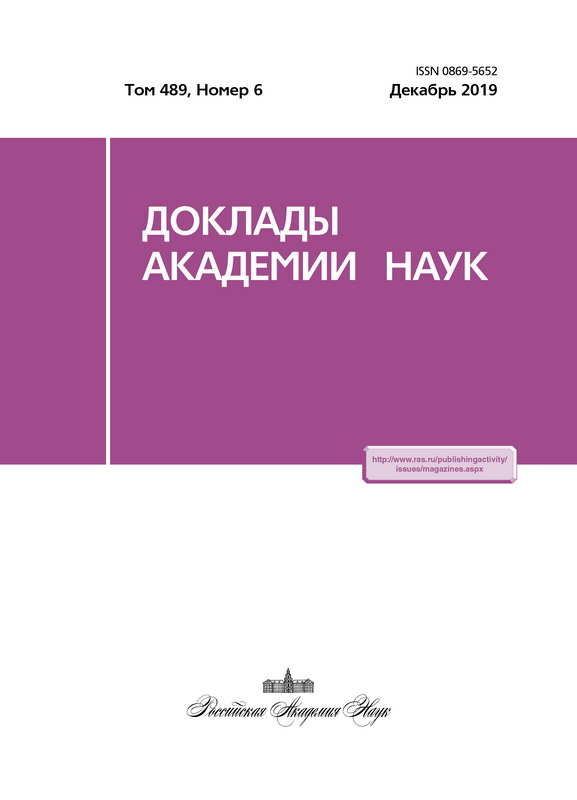Источники обломочного материала терригенных толщ Печенгской структуры по данным изотопного анализа детритового циркона (SIMS SHRIMP-II, LA-ICPMS)
- Авторы: Смолькин В.Ф.1, Межеловская С.В.2, Межеловский А.Д.2
-
Учреждения:
- Государственный геологический музей имени В.И. Вернадского Российской академии наук
- Российский государственный геологоразведочный университет имени Серго Орджоникидзе
- Выпуск: Том 488, № 6 (2019)
- Страницы: 645-650
- Раздел: Геохимия
- URL: https://journals.eco-vector.com/0869-5652/article/view/17760
- DOI: https://doi.org/10.31857/S0869-56524886645-650
- ID: 17760
Цитировать
Аннотация
Представлены результаты исследований рудоносной Печенгской структуры палеопротерозойского возраста, расположенной на северо-западе Кольского региона. Для определения U-Th-Pb-возраста циркона использовалась масс-спектрометрия вторичных ионов на приборе SRHIMP-II и масс-спектрометрия с индуктивно связанной плазмой с лазерной абляцией LA-ICPMS на приборе ThermoQuest Finnigan MAT Neptune. Опробованы базальные конгломераты телевинской, красноцветные гравелиты лучломпольской и высококремнезёмистые турбидиты из средней части разреза матертской свит. На U-Pb-диаграмме с конкордией часть аналитических точек для циркона из конгломератов аппроксимируются дискордией с верхним пересечением 2724 ± 9 и 2792 ± 7 млн лет. Все зёрна циркона из гравелитов располагается на конкордии. Основная часть значений их возраста находится в интервале 2700-2820, меньшая 2840-3000 млн. Единичные зёрна имеют возраст от 3037 ± 4 до 3698 ± 8 млн лет. Для циркона из турбидита установлено конкордантное значение 207Pb/206Pb-возраста 2640 ± 16 млн лет. Источниками циркона для конгломератов и гравелитов были породы фундамента северного обрамления Печенгской структуры: гнейсы комплексов Киркенес, Варангер, Сванвик (2715, 2803 и 2825 млн лет) и высокоглинозёмистые гнейсы (2798-2830 млн лет), для турбидитов - гранитоиды южного борта. Доминирующая роль группы циркона с возрастом 2,7 млрд лет подтверждает глобальный прирост континентальной коры в этот период. Древние значения возраста циркона (3,0-3,7 млрд лет) из красноцветных гравелитов связаны с более глубокой эрозией фундамента и выходом на эрозионную поверхность пород эо- и мезоархейского возраста в северном обрамлении в период первой глобальной “Кислородной революции” (2,4-2,3 млрд лет).
Ключевые слова
Об авторах
В. Ф. Смолькин
Государственный геологический музей имени В.И. Вернадского Российской академии наук
Автор, ответственный за переписку.
Email: v.smolkin@sgm.ru
Россия, 125009, г. Москва, ул. Моховая, 11, стр. 11
С. В. Межеловская
Российский государственный геологоразведочный университет имени Серго Орджоникидзе
Email: v.smolkin@sgm.ru
Россия, 117997, г. Москва, ул. Миклухо-Маклая, 23
А. Д. Межеловский
Российский государственный геологоразведочный университет имени Серго Орджоникидзе
Email: v.smolkin@sgm.ru
Россия, 117997, г. Москва, ул. Миклухо-Маклая, 23
Список литературы
- Смолькин В.Ф. Коматиитовый и пикритовый магматизм раннего докембрия Балтийского щита. СПб.: Наука, 1992. 272 с.
- Williams I.S. // Reviews in Economic Geology. 1998. V. 7. P. 1-35.
- Gehrels G.E., Valencia V.A., Ruiz J. // Geochem. Geophys. Geosyst. 2008. V. 9. Q03017, doi: 10.1029/2007GC001805
- Ludwig, K.R. BGC Special Publication. No. 2. 2000. 2455 Ridge Road, Berkeley, CA 94709, USA.
- Ludwig K.R. BGC Special Publication No.1. 2003. 2455 Ridge Road, Berkeley CA 94709, USA.
- Магматизм, седиментогенез и геодинамика Печенгской палеорифтогенной структуры. Апатиты: КНЦ АН СССР. Под ред.: Ф.П. Митрофанова, В.Ф. Смолькина. 1995. 240 с.
- Баянова Т.Б., Смолькин В.Ф., Левкович Н.В. // Геохимия. 1999. № 1. C. 1-11.
- Кольская сверхглубокая. Научные результаты и опыт исследований. М.: МФ “ТЕХНОНЕФТЕГАЗ”. 1998. 260 c.
- Gärtner C., Bahlbung Y., Melezhik V., Berndt J. // Precambrian Res. 2014. V. 246. P. 281-295.
- Ветрин В.Р., Чупин В.П., Яковлев Ю.Н. // Литосфера. 2013. № 5. С. 3-25.
- Ветрин В.Р., Белоусова Е.А., Чупин В.П. // Геохимия. 2016. № 1. C. 105-125.
- Condie K.C., Aster R.C. // Precambrian Res. 2010. V. 180. P. 227-236.
- Мыскова Т.А., Бережная Н.Г., Глебовицкий В.А. и др. // ДАН. 2005. Т. 402. №1. С. 82-86.
Дополнительные файлы








